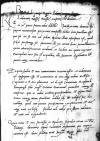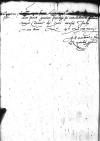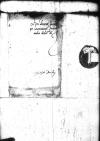Intelleximus dominum Mauritius Ferber (*1471 – †1537), doctor of both canon and civil law; from 1507 Canon of Ermland (Warmia) and Lübeck; from 1514 Canon of Trier; 1512-1515 parish priest of the Church of Saints Peter and Paul in Gdańsk (Danzig); from 1516 Custos of Ermland and parish priest of the Church of the Blessed Virgin Mary in Gdańsk; from 1519 Canon of Dorpat; from 1523 Canon of Revel; 1523-1537 Bishop of Ermland (KOPICZKO 2, p. 71-72; SBKW, p. 59-60)⌊episcopum VarmiensemMauritius Ferber (*1471 – †1537), doctor of both canon and civil law; from 1507 Canon of Ermland (Warmia) and Lübeck; from 1514 Canon of Trier; 1512-1515 parish priest of the Church of Saints Peter and Paul in Gdańsk (Danzig); from 1516 Custos of Ermland and parish priest of the Church of the Blessed Virgin Mary in Gdańsk; from 1519 Canon of Dorpat; from 1523 Canon of Revel; 1523-1537 Bishop of Ermland (KOPICZKO 2, p. 71-72; SBKW, p. 59-60)⌋ proximis transactis diebus vita functum esse. Quo fit, ut Paternitas Tua ad sedem episcopatus illius ascensura est, quod felix faustumque sit. Favemus illi ex animo hanc provectionem, quam administraturam credimus in laudem Dei Optimi Maximi, Sigismund I Jagiellon (Zygmunt I) (*1467 – †1548), King of Poland and Grand Duke of Lithuania (1506-1548); Duke of Głogów (Glogau) (1499-1506), Duke of Opava (1501-1506), Governor of Silesia (1504-1506); son of King Kazimierz IV Jagiellon and Elisabeth of Austria
Bona Sforza (*1494 – †1557), Queen of Poland and Grand Duchess of Lithuania (1518-1557); the second wife of Sigismund I Jagiellon; Duchess of Bari and Rossano; daughter of Gian Galeazzo Sforza of Milan and Isabella of Aragon
Sigismund II Augustus Jagiellon (Zygmunt II August) (*1520 – †1572), 1529-1572 Grand Duke of Lithuania (ruled from 1544); 1530-1572 King of Poland (crowned vivente rege (ruled from 1548, after the death of his father); son of Sigismund I Jagiellon and Bona Sforza⌊principibusSigismund I Jagiellon (Zygmunt I) (*1467 – †1548), King of Poland and Grand Duke of Lithuania (1506-1548); Duke of Głogów (Glogau) (1499-1506), Duke of Opava (1501-1506), Governor of Silesia (1504-1506); son of King Kazimierz IV Jagiellon and Elisabeth of Austria
Bona Sforza (*1494 – †1557), Queen of Poland and Grand Duchess of Lithuania (1518-1557); the second wife of Sigismund I Jagiellon; Duchess of Bari and Rossano; daughter of Gian Galeazzo Sforza of Milan and Isabella of Aragon
Sigismund II Augustus Jagiellon (Zygmunt II August) (*1520 – †1572), 1529-1572 Grand Duke of Lithuania (ruled from 1544); 1530-1572 King of Poland (crowned vivente rege (ruled from 1548, after the death of his father); son of Sigismund I Jagiellon and Bona Sforza⌋ vero suis et Poland (Kingdom of Poland, Polonia)⌊reipublicaePoland (Kingdom of Poland, Polonia)⌋ illi honorem, dignitatem et pacem, atque commodum.
Et quia habet Paternitas Tua Canonicatum Varmiensem et indecorum est episcopatum esse et canonicum in una atque eadem ecclesia, cupimus a Paternitate Tua plurimum, ut de ipso canonicatu Rafał Konopacki (Raphael von Konopat) (*ca. 1510 – †ca. 1570), son of Jerzy Konopacki (Georg von Konopat) and Anna Peckau, younger brother of Jan Konopacki, Canon of Ermland; converted to Protestantism in the last years of his life; 1533-1537 courtier of Vice-Chancellor Piotr Tomicki, 1539-1547 Canon of Ermland (Warmia) (nominated in 1537 by Queen Bona Sforza), 1547-1549 Chamberlain of Marienburg (Malbork), 1549-1551 Chamberlain of Kulm (Chełmno), 1551-1570 Castellan of Elbing (Elbląg) (SBPN 2, p. 438; NOWOSAD 2014, p. 74-80; SBKW, p. 121; KOPICZKO 2, p. 161)⌊Raphaeli KonopaczkiRafał Konopacki (Raphael von Konopat) (*ca. 1510 – †ca. 1570), son of Jerzy Konopacki (Georg von Konopat) and Anna Peckau, younger brother of Jan Konopacki, Canon of Ermland; converted to Protestantism in the last years of his life; 1533-1537 courtier of Vice-Chancellor Piotr Tomicki, 1539-1547 Canon of Ermland (Warmia) (nominated in 1537 by Queen Bona Sforza), 1547-1549 Chamberlain of Marienburg (Malbork), 1549-1551 Chamberlain of Kulm (Chełmno), 1551-1570 Castellan of Elbing (Elbląg) (SBPN 2, p. 438; NOWOSAD 2014, p. 74-80; SBKW, p. 121; KOPICZKO 2, p. 161)⌋, filio magnifici Jerzy Konopacki Sr (Georg von Konopat) (*ca. 1480 – †1543), brother of Jan Konopacki, Bishop of Kulm (Chełmno); 1512-1516 Chamberlain of Pomerania; 1516-1518 Castellan of Gdańsk (Danzig); 1518-1543 Voivode of Pomerania (PSB 13, p. 547-548)⌊palatini PomeraniaeJerzy Konopacki Sr (Georg von Konopat) (*ca. 1480 – †1543), brother of Jan Konopacki, Bishop of Kulm (Chełmno); 1512-1516 Chamberlain of Pomerania; 1516-1518 Castellan of Gdańsk (Danzig); 1518-1543 Voivode of Pomerania (PSB 13, p. 547-548)⌋, provideat eumque illi conferat. Qua de re nobis multum gratificabitur et ipsum Jerzy Konopacki Sr (Georg von Konopat) (*ca. 1480 – †1543), brother of Jan Konopacki, Bishop of Kulm (Chełmno); 1512-1516 Chamberlain of Pomerania; 1516-1518 Castellan of Gdańsk (Danzig); 1518-1543 Voivode of Pomerania (PSB 13, p. 547-548)⌊palatinumJerzy Konopacki Sr (Georg von Konopat) (*ca. 1480 – †1543), brother of Jan Konopacki, Bishop of Kulm (Chełmno); 1512-1516 Chamberlain of Pomerania; 1516-1518 Castellan of Gdańsk (Danzig); 1518-1543 Voivode of Pomerania (PSB 13, p. 547-548)⌋ eiusque totam familiam reddet sibi et Ermland (Warmia, Varmia), diocese and ecclesiastical principality in northeastern Poland, 1466-1772 within the Kingdom of Poland, Royal Prussia⌊ecclesiaeErmland (Warmia, Varmia), diocese and ecclesiastical principality in northeastern Poland, 1466-1772 within the Kingdom of Poland, Royal Prussia⌋ suae devinctam. Quod non parum profuturum existimamus Paternitati Tuae atque eius Ermland (Warmia, Varmia), diocese and ecclesiastical principality in northeastern Poland, 1466-1772 within the Kingdom of Poland, Royal Prussia⌊ecclesiaeErmland (Warmia, Varmia), diocese and ecclesiastical principality in northeastern Poland, 1466-1772 within the Kingdom of Poland, Royal Prussia⌋. Scribat autem nobis per hunc nuntium et voto nostro respondeat.
Quia vero Paternitas Tua successit in episcopatum, succedat etiam in tributum. Dominus episcopus Varmiensis Mauritius Ferber (*1471 – †1537), doctor of both canon and civil law; from 1507 Canon of Ermland (Warmia) and Lübeck; from 1514 Canon of Trier; 1512-1515 parish priest of the Church of Saints Peter and Paul in Gdańsk (Danzig); from 1516 Custos of Ermland and parish priest of the Church of the Blessed Virgin Mary in Gdańsk; from 1519 Canon of Dorpat; from 1523 Canon of Revel; 1523-1537 Bishop of Ermland (KOPICZKO 2, p. 71-72; SBKW, p. 59-60)⌊MauriciusMauritius Ferber (*1471 – †1537), doctor of both canon and civil law; from 1507 Canon of Ermland (Warmia) and Lübeck; from 1514 Canon of Trier; 1512-1515 parish priest of the Church of Saints Peter and Paul in Gdańsk (Danzig); from 1516 Custos of Ermland and parish priest of the Church of the Blessed Virgin Mary in Gdańsk; from 1519 Canon of Dorpat; from 1523 Canon of Revel; 1523-1537 Bishop of Ermland (KOPICZKO 2, p. 71-72; SBKW, p. 59-60)⌋, qui nuper mortuus est, dare solitus erat serenissimo regi Sigismund II Augustus Jagiellon (Zygmunt II August) (*1520 – †1572), 1529-1572 Grand Duke of Lithuania (ruled from 1544); 1530-1572 King of Poland (crowned vivente rege (ruled from 1548, after the death of his father); son of Sigismund I Jagiellon and Bona Sforza⌊filioSigismund II Augustus Jagiellon (Zygmunt II August) (*1520 – †1572), 1529-1572 Grand Duke of Lithuania (ruled from 1544); 1530-1572 King of Poland (crowned vivente rege (ruled from 1548, after the death of his father); son of Sigismund I Jagiellon and Bona Sforza⌋ nostro  BCz, 1596, p. 448 carissimo equos bonos Germanicos de equirea sua on the margin⌈de equirea suade equirea sua on the margin⌉. Volumus stain⌈[umus]umus stain⌉, ut Paternitas Tua idem faciat. Gratiam principis sui cumulatiorem habebit.
BCz, 1596, p. 448 carissimo equos bonos Germanicos de equirea sua on the margin⌈de equirea suade equirea sua on the margin⌉. Volumus stain⌈[umus]umus stain⌉, ut Paternitas Tua idem faciat. Gratiam principis sui cumulatiorem habebit.
 BCz, 1596, p. 448 carissimo equos bonos Germanicos de equirea sua on the margin⌈de equirea suade equirea sua on the margin⌉. Volumus stain⌈[umus]umus stain⌉, ut Paternitas Tua idem faciat. Gratiam principis sui cumulatiorem habebit.
BCz, 1596, p. 448 carissimo equos bonos Germanicos de equirea sua on the margin⌈de equirea suade equirea sua on the margin⌉. Volumus stain⌈[umus]umus stain⌉, ut Paternitas Tua idem faciat. Gratiam principis sui cumulatiorem habebit.

